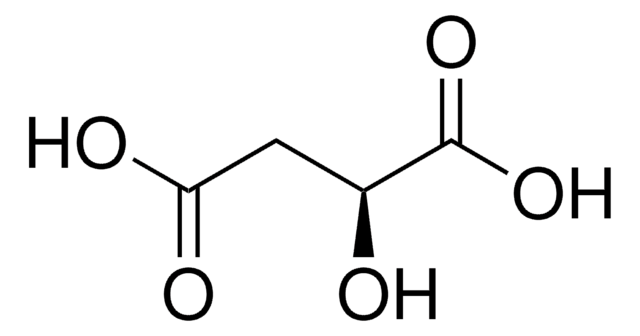P4761
Poly-L-glutamic acid sodium salt
mol wt 15,000-50,000
Synonym(s):
L-Glutamic acid homopolymer sodium salt
About This Item
Recommended Products
form
powder
mol wt
15,000-50,000
color
white to off-white
application(s)
detection
storage temp.
−20°C
InChI
1S/C15H23N3O10/c16-7(1-4-10(19)20)13(25)17-8(2-5-11(21)22)14(26)18-9(15(27)28)3-6-12(23)24/h7-9H,1-6,16H2,(H,17,25)(H,18,26)(H,19,20)(H,21,22)(H,23,24)(H,27,28)/t7-,8-,9-/m0/s1
InChI key
BUZMZDDKFCSKOT-CIUDSAMLSA-N
Looking for similar products? Visit Product Comparison Guide
Application
- Effect of Micelle-Incorporated Cisplatin With Sizes Ranging From 8 to 40 nm for the Therapy of Lewis Lung Carcinoma.: This research explores the use of micelle-incorporated cisplatin nanoparticles for cancer therapy, highlighting the significance of particle size on therapeutic efficacy. Poly-ʟ-glutamic acid sodium salt is used to improve drug delivery and target specificity (Wang Z et al., 2021).
- Ternary Polypeptide Nanoparticles with Improved Encapsulation, Sustained Release, and Enhanced In Vitro Efficacy of Carfilzomib.: This paper describes the development of ternary polypeptide nanoparticles, including poly-ʟ-glutamic acid sodium salt, to enhance the encapsulation and release of carfilzomib, an anticancer drug. The study demonstrates improved drug efficacy and controlled release profiles (Agbana P et al., 2020).
- Polymeric Core-Shell Nanoparticles Prepared by Spontaneous Emulsification Solvent Evaporation and Functionalized by the Layer-by-Layer Method.: This research focuses on the preparation of polymeric core-shell nanoparticles using a spontaneous emulsification method. Poly-ʟ-glutamic acid sodium salt is used to functionalize these nanoparticles, which can be applied in drug delivery systems (Szczęch M et al., 2020).
- Co-administration of Combretastatin A4 Nanoparticles and Sorafenib for Systemic Therapy of Hepatocellular Carcinoma.: This study evaluates the combined use of combretastatin A4 nanoparticles and sorafenib for treating liver cancer. Poly-ʟ-glutamic acid sodium salt is employed to enhance the stability and delivery of these nanoparticles, showing promise in improving therapeutic outcomes (Wang Y et al., 2019).
Analysis Note
Other Notes
Storage Class Code
11 - Combustible Solids
WGK
WGK 3
Flash Point(F)
Not applicable
Flash Point(C)
Not applicable
Personal Protective Equipment
Certificates of Analysis (COA)
Search for Certificates of Analysis (COA) by entering the products Lot/Batch Number. Lot and Batch Numbers can be found on a product’s label following the words ‘Lot’ or ‘Batch’.
Already Own This Product?
Find documentation for the products that you have recently purchased in the Document Library.
Articles
Recently, layer-by-layer (LbL) assembly has emerged as a versatile, gentle and, simple method for immobilization of functional molecules in an easily controllable thin film morphology.1,2 In this short review, we introduce recent advances in functional systems fabricated by using the mild, yet adaptable LbL technique.
Humankind has utilized protein materials throughout its existence, starting with the use of materials such as wool and silk for warmth and protection from the elements and continuing with the use of recombinant DNA techniques to synthesize proteins with unique and useful properties.
Our team of scientists has experience in all areas of research including Life Science, Material Science, Chemical Synthesis, Chromatography, Analytical and many others.
Contact Technical Service





